PORSCHE CAYNNE 2008 1.G Information Manual
Manufacturer: PORSCHE, Model Year: 2008, Model line: CAYENNE, Model: PORSCHE CAYENNE 2008 1.GPages: 95, PDF Size: 3.37 MB
Page 41 of 95
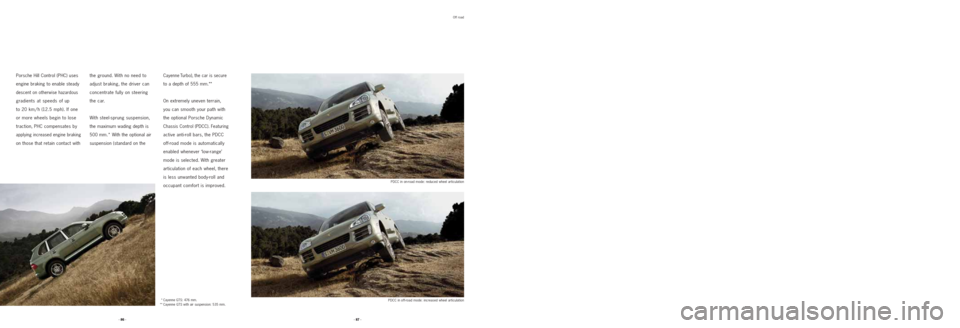
Off road
Porsche Hill Control (PHC) uses
engine braking to enable steady
descent on otherwise hazardous
gradients at speeds of up
to 20 km / h (12.5 mph). If one
or more wheels begin to lose
traction, PHC compensates by
applying increased engine braking
on those that retain contact withthe ground. With no need to
adjust braking, the driver can
concentrate fully on steering
the car.
With steel-sprung suspension,
the maximum wading depth is
500 mm.* With the optional air
suspension (standard on the
Cayenne Turbo), the car is secure
to a depth of 555 mm.**
On extremely uneven terrain,
you can smooth your path with
the optional Porsche Dynamic
Chassis Control (PDCC). Featuring
active anti-roll bars, the PDCC
off-road mode is automatically
enabled whenever ‘low-range’
mode is selected. With greater
articulation of each wheel, there
is less unwanted body-roll and
occupant comfort is improved.
PDCC in on-road mode: reduced wheel articulation
PDCC in off-road mode: increased wheel articulation
**Cayenne GTS: 476 mm.** Cayenne GTS with air suspension: 535 mm.
· 87 · · 86 ·
Page 42 of 95

Off road
Applying power with sensitivity, protecting with strength.
Off-road Technology package.
The rear differential enables
optimum distribution of engine
torque in difficult off-road terrain.
A fully automated part of the
all-wheel system, its primary
function is to optimise traction.
If one of the rear wheels begins
to lose grip, the differential varies
the torque transmitted through
each drive shaft, thereby restoring
traction. Available as a factory-fitted
option on all Cayenne models, the
Off-road Technology package*
incorporates an electronically
variable and lockable rear
differential as part of the standard
all-wheel drive system. Other
features include high-strength
rock-rails with integrated skid
plates, a reinforced engine-bay
guard, enhanced protection for
the fuel tank and rear axle, and
a second towing lug.In low-range mode, the rear
differential can be manually
locked using the main off-road
control on the centre console.
In this state, both rear wheels
receive the same amount of
torque.
For additional off-road protection,
optional wheel-arch extensions
(black finish) and running boards*
with integrated skid plates are
available.
* Not available for the Cayenne GTS.
· 89 · · 88 ·
Page 43 of 95

SafetyFinding new ways.
Breaking new ground.
Yet always prepared
for every eventuality.That’s always been our
philosophy at Porsche –
and fundamental to the
Cayenne models.
· 91 · · 90 ·
Page 44 of 95
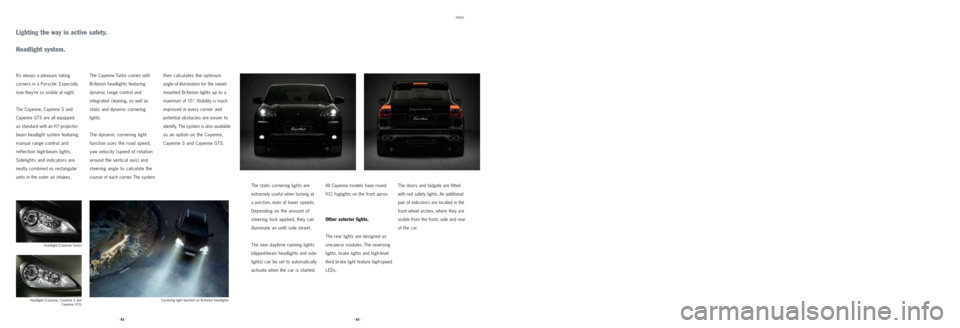
The Cayenne Turbo comes with
Bi-Xenon headlights featuring
dynamic range control and
integrated cleaning, as well as
static and dynamic cornering
lights.
The dynamic cornering light
function uses the road speed,
yaw velocity (speed of rotation
around the vertical axis) and
steering angle to calculate the
course of each corner. The system
Lighting the way in active safety.
Headlight system.
Safety
The static cornering lights are
extremely useful when turning at
a junction, even at lower speeds.
Depending on the amount of
steering lock applied, they can
illuminate an unlit side street.
The new daytime running lights
(dipped-beam headlights and side-
lights) can be set to automatically
activate when the car is started.
Headlight (Cayenne, Cayenne S and
Cayenne GTS)
All Cayenne models have round
H11 foglights on the front apron.
Other exterior lights.
The rear lights are designed as
one-piece modules. The reversing
lights, brake lights and high-level
third brake light feature high-speed
LEDs.The doors and tailgate are fitted
with red safety lights. An additional
pair of indicators are located in the
front wheel arches, where they are
visible from the front, side and rear
of the car.
Cornering light function on Bi-Xenon headlights
then calculates the optimum
angle of illumination for the swivel-
mounted Bi-Xenon lights up to a
maximum of 15°. Visibility is much
improved in every corner and
potential obstacles are easier to
identify. The system is also available
as an option on the Cayenne,
Cayenne S and Cayenne GTS.
Headlight (Cayenne Turbo)
It’s always a pleasure taking
corners in a Porsche. Especially
now they’re so visible at night.
The Cayenne, Cayenne S and
Cayenne GTS are all equipped
as standard with an H7 projector-
beam headlight system featuring
manual range control and
reflection high-beam lights.
Sidelights and indicators are
neatly combined as rectangular
units in the outer air intakes.
· 93 · · 92 ·
Page 45 of 95
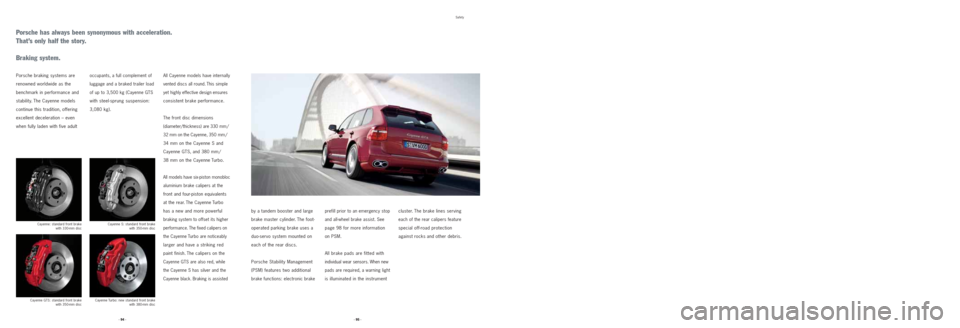
by a tandem booster and large
brake master cylinder. The foot-
operated parking brake uses a
duo-servo system mounted on
each of the rear discs.
Porsche Stability Management
(PSM) features two additional
brake functions: electronic brake
Porsche braking systems are
renowned worldwide as the
benchmark in performance and
stability. The Cayenne models
continue this tradition, offering
excellent deceleration – even
when fully laden with five adult
Porsche has always been synonymous with acceleration.
That’s only half the story.
Braking system.
All Cayenne models have internally
vented discs all round. This simple
yet highly effective design ensures
consistent brake performance.
The front disc dimensions
(diameter/thickness) are 330 mm /
32 mm on the Cayenne, 350 mm /
34 mm on the Cayenne S and
Cayenne GTS, and 380 mm /
38 mm on the Cayenne Turbo.
All models have six-piston monobloc
aluminium brake calipers at the
front and four-piston equivalents
at the rear. The Cayenne Turbo
has a new and more powerful
braking system to offset its higher
performance. The fixed calipers on
the Cayenne Turbo are noticeably
larger and have a striking red
paint finish. The calipers on the
Cayenne GTS are also red, while
the Cayenne S has silver and the
Cayenne black. Braking is assisted
Safety
occupants, a full complement of
luggage and a braked trailer load
of up to 3,500 kg (Cayenne GTS
with steel-sprung suspension:
3,080 kg).
prefill prior to an emergency stop
and all-wheel brake assist. See
page 98 for more information
on PSM.
All brake pads are fitted with
individual wear sensors. When new
pads are required, a warning light
is illuminated in the instrumentcluster. The brake lines serving
each of the rear calipers feature
special off-road protection
against rocks and other debris.
· 95 · · 94 · Cayenne: standard front brake
with 330-mm discCayenne S: standard front brake
with 350-mm disc
Cayenne GTS: standard front brake
with 350-mm discCayenne Turbo: new standard front brake
with 380-mm disc
Page 46 of 95
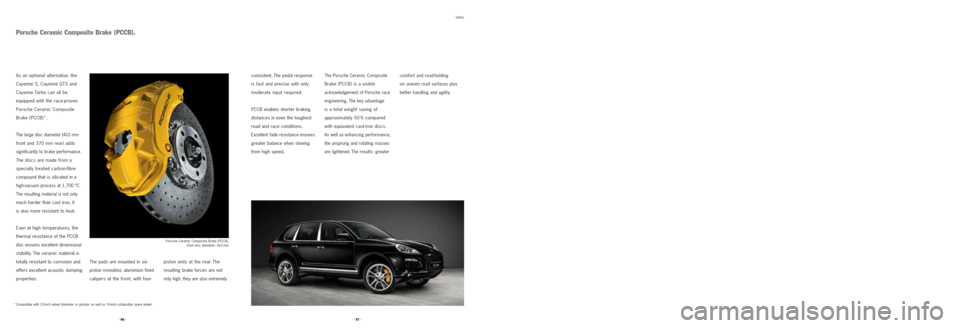
piston units at the rear. The
resulting brake forces are not
only high, they are also extremely
Porsche Ceramic Composite Brake (PCCB).
Porsche Ceramic Composite Brake (PCCB),
front disc diameter: 410 mm
The pads are mounted in six-
piston monobloc aluminium fixed
calipers at the front, with four-
Safety
As an optional alternative, the
Cayenne S, Cayenne GTS and
Cayenne Turbo can all be
equipped with the race-proven
Porsche Ceramic Composite
Brake (PCCB)*.
The large disc diameter (410 mm
front and 370 mm rear) adds
significantly to brake performance.
The discs are made from a
specially treated carbon-fibre
compound that is silicated in a
high-vacuum process at 1,700 ºC.
The resulting material is not only
much harder than cast iron, it
is also more resistant to heat.
Even at high temperatures, the
thermal resistance of the PCCB
disc ensures excellent dimensional
stability. The ceramic material is
totally resistant to corrosion and
offers excellent acoustic damping
properties.consistent. The pedal response
is fast and precise with only
moderate input required.
PCCB enables shorter braking
distances in even the toughest
road and race conditions.
Excellent fade resistance ensures
greater balance when slowing
from high speed.
· 97 · · 96 ·
The Porsche Ceramic Composite
Brake (PCCB) is a visible
acknowledgement of Porsche race
engineering. The key advantage
is a total weight saving of
approximately 50 % compared
with equivalent cast-iron discs.
As well as enhancing performance,
the unsprung and rotating masses
are lightened. The results: greater
comfort and road-holding
on uneven road surfaces plus
better handling and agility.
* Compatible with 20-inch wheel diameter or greater as well as 19-inch collapsible spare wheel.
Page 47 of 95
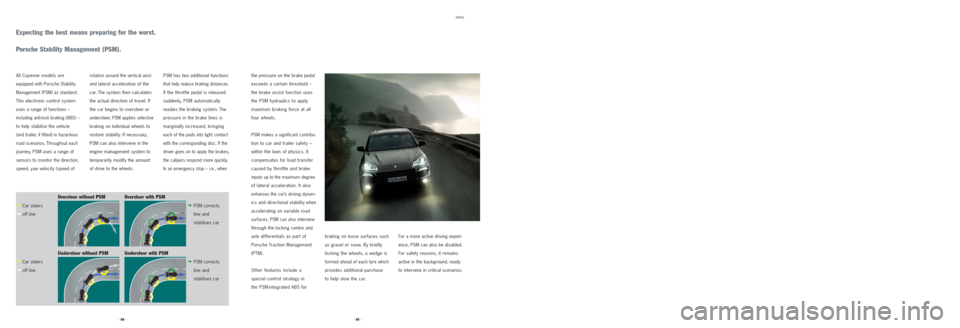
Oversteer with PSM
Understeer without PSM
Car steers
off line Car steers
off line PSM corrects
line and
stabilises car
PSM corrects
line and
stabilises car
Understeer with PSM Oversteer without PSM
All Cayenne models are
equipped with Porsche Stability
Management (PSM) as standard.
This electronic control system
uses a range of functions –
including anti-lock braking (ABS) –
to help stabilise the vehicle
(and trailer, if fitted) in hazardous
road scenarios. Throughout each
journey, PSM uses a range of
sensors to monitor the direction,
speed, yaw velocity (speed of
rotation around the vertical axis)
and lateral acceleration of the
car. The system then calculates
the actual direction of travel. If
the car begins to oversteer or
understeer, PSM applies selective
braking on individual wheels to
restore stability. If necessary,
PSM can also intervene in the
engine management system to
temporarily modify the amount
of drive to the wheels.PSM has two additional functions
that help reduce braking distances.
If the throttle pedal is released
suddenly, PSM automatically
readies the braking system. The
pressure in the brake lines is
marginally increased, bringing
each of the pads into light contact
with the corresponding disc. If the
driver goes on to apply the brakes,
the calipers respond more quickly.
In an emergency stop – i.e., when
the pressure on the brake pedal
exceeds a certain threshold –
the brake assist function uses
the PSM hydraulics to apply
maximum braking force at all
four wheels.
PSM makes a significant contribu-
tion to car and trailer safety –
within the laws of physics. It
compensates for load transfer
caused by throttle and brake
inputs up to the maximum degree
of lateral acceleration. It also
enhances the car’s driving dynam-
ics and directional stability when
accelerating on variable road
surfaces. PSM can also intervene
through the locking centre and
axle differentials as part of
Porsche Traction Management
(PTM).
Other features include a
special control strategy in
the PSM-integrated ABS for braking on loose surfaces such
as gravel or snow. By briefly
locking the wheels, a wedge is
formed ahead of each tyre which
provides additional purchase
to help slow the car.
For a more active driving experi-
ence, PSM can also be disabled.
For safety reasons, it remains
active in the background, ready
to intervene in critical scenarios.
Expecting the best means preparing for the worst.
Porsche Stability Management (PSM).
Safety
· 99 · · 98 ·
Page 48 of 95
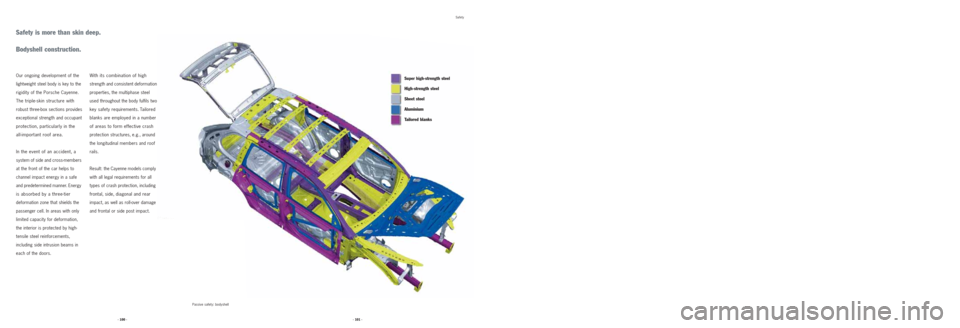
Our ongoing development of the
lightweight steel body is key to the
rigidity of the Porsche Cayenne.
The triple-skin structure with
robust three-box sections provides
exceptional strength and occupant
protection, particularly in the
all-important roof area.
In the event of an accident, a
system of side and cross-members
at the front of the car helps to
channel impact energy in a safe
and predetermined manner. Energy
is absorbed by a three-tier
deformation zone that shields the
passenger
cell. In areas with only
limited capacity for deformation,
the interior is protected by high-
tensile steel reinforcements,
including side intrusion beams in
each of the doors.
Safety is more than skin deep.
Bodyshell construction.
Safety
With its combination of high
strength and consistent deformation
properties, the multiphase steel
used throughout the body fulfils two
key safety requirements. Tailored
blanks are employed in a number
of areas to form effective crash
protection structures, e.g., around
the longitudinal members and roof
rails.
Result: the Cayenne models comply
with all legal requirements for all
types of crash protection, including
frontal, side, diagonal and rear
impact, as well as roll-over damage
and frontal or side post impact.Super high-strength steel
High-strength steel
Sheet steel
Aluminium
Tailored blanks
· 101 · · 100 ·Passive safety: bodyshell
Page 49 of 95
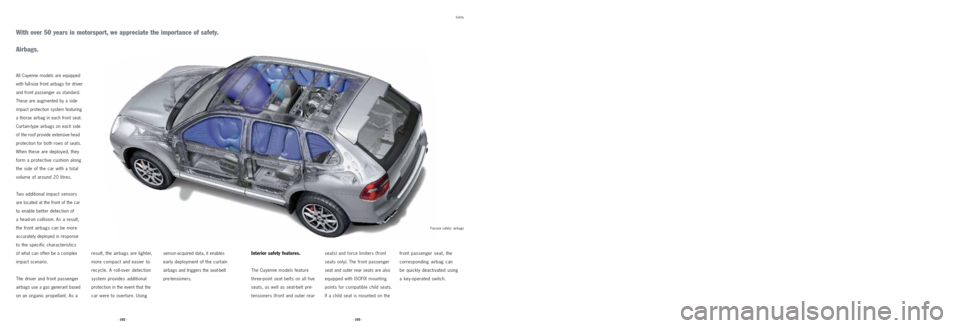
With over 50 years in motorsport, we appreciate the importance of safety.
Airbags.
All Cayenne models are equipped
with full-size front airbags for driver
and front passenger as standard.
These are augmented by a side-
impact protection system featuring
a thorax airbag in each front seat.
Curtain-type airbags on each side
of the roof provide extensive head
protection for both rows of seats.
When these are deployed, they
form a protective cushion along
the side of the car with a total
volume of around 20 litres.
Two additional impact sensors
are located at the front of the car
to enable better detection of
a head-on collision. As a result,
the front airbags can be more
accurately deployed in response
to the specific characteristics
of what can often be a complex
impact scenario.
The driver and front passenger
airbags use a gas generant based
on an organic propellant. As aresult, the airbags are lighter,
more compact and easier to
recycle. A roll-over detection
system provides additional
protection in the event that the
car were to overturn. Using
sensor-acquired data, it enables
early deployment of the curtain
airbags and triggers the seat-belt
pre-tensioners.
Interior safety features.
The Cayenne models feature
three-point seat belts on all five
seats, as well as seat-belt pre-
tensioners (front and outer rearseats) and force limiters (front
seats only). The front passengerseat and outer rear seats are also
equipped with ISOFIX mounting
points for compatible child seats.
If a child seat is mounted on the
front passenger seat, the
corresponding airbag can
be quickly deactivated using
a key-operated switch.
Safety
· 103 · · 102 ·Passive safety: airbags
Page 50 of 95
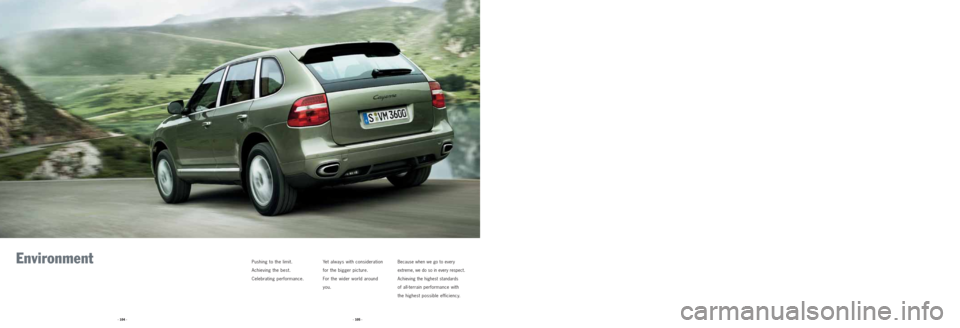
Environment Pushing to the limit.
Achieving the best.
Celebrating performance.Yet always with consideration
for the bigger picture.
For the wider world around
you.Because when we go to every
extreme, we do so in every respect.
Achieving the highest standards
of all-terrain performance with
the highest possible efficiency.
· 105 · · 104 ·